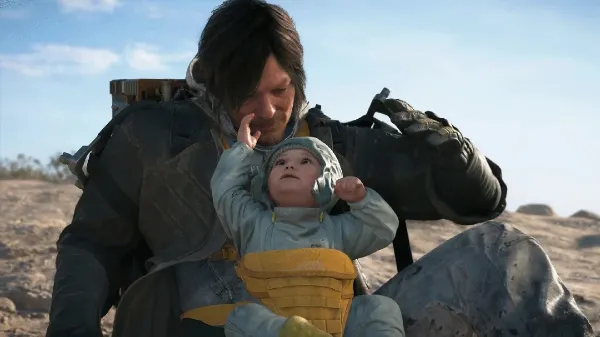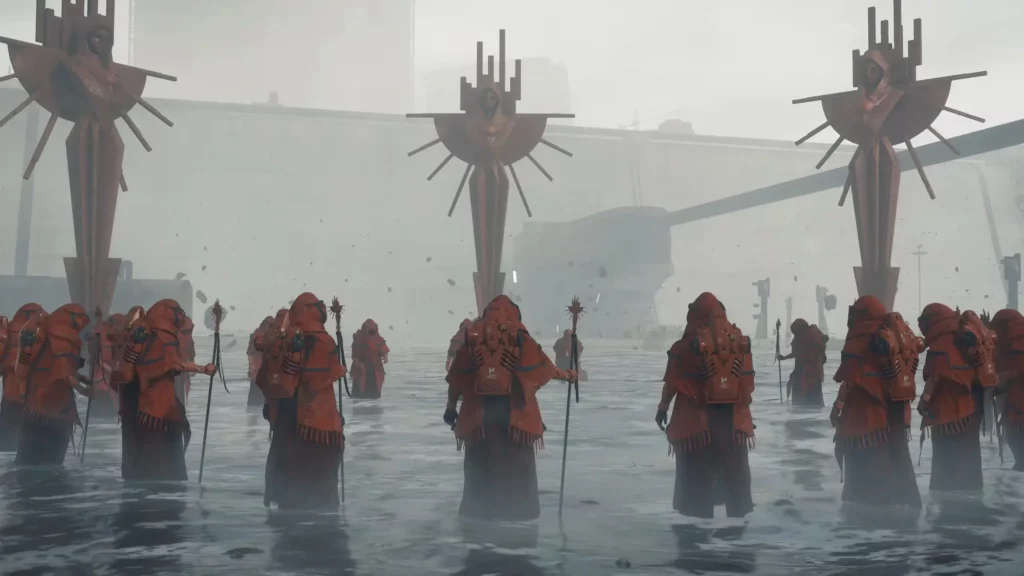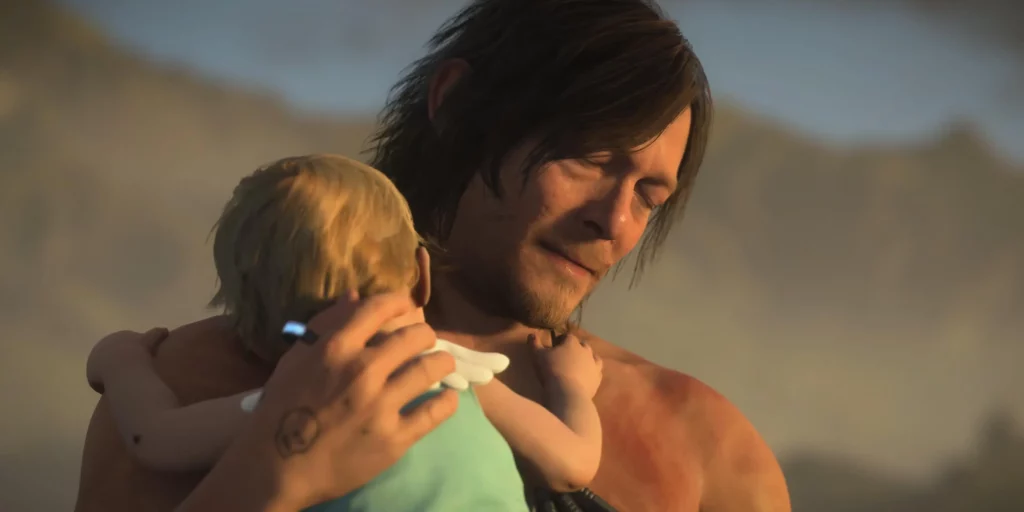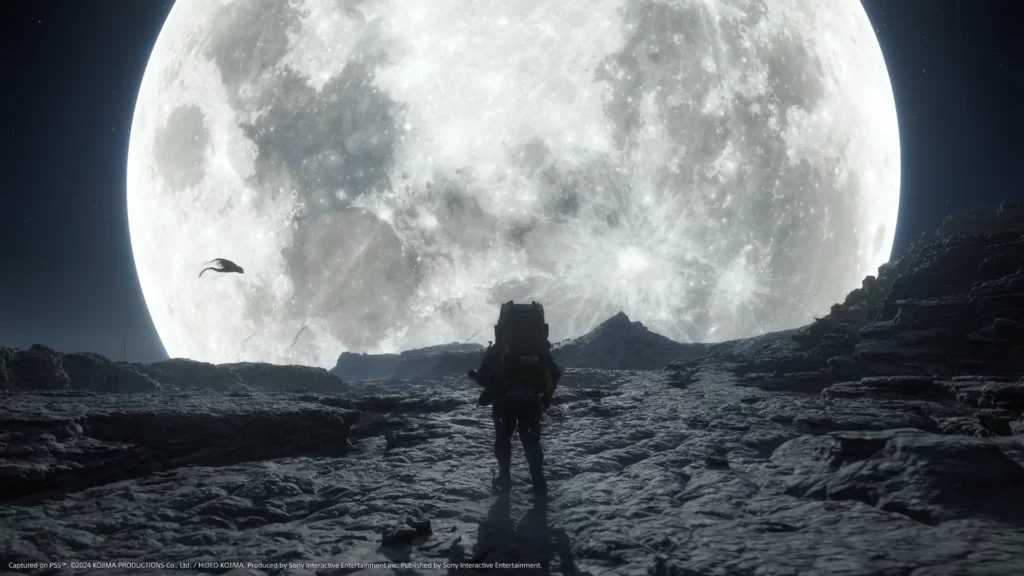Death Stranding 2: On The Beach expects players to have played the first game, and to understand all of the weird story beats. Using BBs to deliver packages isn’t exactly something players will find easy to do. It goes on to assume that these players want an even more lavish version of that experience, one thick with odd characters, dense worldbuilding, and heavy emotional themes. Players who hit all of the aforementioned markers should expect some intriguing experiences when engaging with the sequel – weird, maybe a little uneven and definitely unforgettable. Expect a 30 to 50 hour play time.
But there’s almost a hidden assumption as well: that anyone who found the first title boring, abstract or just plain weird, will find it even harder to enjoy this one. If you did not enjoy the slow pacing or mechanics of the first game, you won’t like the sequel either.
Attempting to Explain the Premise
It’s not an easy job to summarise the events of the first Death Stranding and how it sets up the second one. It seems that even the developers acknowledge this, as the Death Stranding 2 recap does not go into too much detail. Yet, the basics are as follows.
The line joining the life and death has become porous enough to allow ghost-like creatures, popularly called BTs, which stand for “beached things,” to crossover. If you touch one of them, it will blow up – destroying everything around. The lead character, Sam Porter Bridges, who is played by Norman Reedus, can come back from the dead as he is a “repatriate”. By crossing through the Chiral Network, which links the dead and living, he can do this rare skill. He manages to traverse the empty land and unite scattered people with limited cargo.
In the original game, Sam manages to reconnect the United States thanks to a mysterious baby in a life-preserving pod. This journey concluded with a betrayal, with his adopted sister being a supernatural who was intending to start a new extinction event. Fortunately, she was convinced to abandon her plan. Sam was also able to stop Higgs, an antagonist who was helping orchestrate this apocalypse. The game ended with Sam running away with a freed baby who was starting to grow into a normal child.

A New Mission in a New Land
The second game starts off with Sam living in Mexico raising the toddler now. This calm does not last. Sam’s life has changed forever after a tragic incident. His past is connected to Fragile (Léa Seydoux), who has come with new business. She requests Sam to take on another enormous job, this time travelling across the whole expanse of Australia to connect terminals from isolated locations into the Chiral Network, similar to in America.
This begins a long trek across many landscapes. Sam has to keep load deliveries organized, snag animals, avoid danger, and slowly put the country together piece by piece. As he continues the journey, he is joined by an odd group of people who became his family. They help Sam with his mission but also help him deal with his emotional trauma.
Too Much Going on at Once
Death Stranding 2 has too many things that are happening in its story. Such that keeping up becomes difficult as there are various plots and subplots going on at once. Even though you get an in-game encyclopedia you can check at any time (cutscenes, included), the overwhelming narrative threads continue. The many characters and their plots meant that many of them were either unnamed or lacked depth.
Sam meets many returning characters like Fragile, Heartman, and others while meeting new ones too, like the Tarman, Rainy, Dollman and Tomorrow. Even though they have a lot of potential, most of these characters only appear in cutscenes. Dollman is the only one that goes with Sam through all of the Australian expedition. Dollman is always there. Most of the others, although well-written and distinctly different, are ignored.

Companionship in Theory, Isolation in Practice
The game repeatedly emphasises that Sam is no longer alone. His friends say he can lean on them emotionally and physically doing this hard job of linking Australia and finding out about the once-podded child. Yet, in gameplay, this support system is rarely felt. Aside from Dollman, Sam’s so-called partners mostly appear infrequently or stay in the background, giving a sense of solitude despite the narrative claim of team-up.
A Climax Filled with Secrets and Surprises
The game’s closing act is full of revelations, hidden identities, and betrayals. Though these twists lead to a thrilling ride, they make one feel more confused. One good thing about this section of the game is that the main characters get a lot more attention, as they start to engage with the gameplay, rather than just showing up in cutscenes.
However, the ending itself is far from neat. The conclusion feels chaotic and forced instead of fulfilling and creating an emotional resonance in viewers. It looks like the writers only came to know about tying everything up on the last pages itself. So, they hurriedly concluded the narrative that actually created more questions. Although there are some very funny moments; it is difficult to come away with a strong sense about if bringing humanity back together was such a good idea after all. The game seems to entertain a “Maybe” reply.

Despite Flaws, It Still Delivers Joy
Regardless of the messy storyline and a conclusion that doesn’t really work, we still enjoy it. Delivering cargo is what makes the game enjoyable and fun. From transport to movement to physicality, the game loop is satisfying in a way that few games manage to achieve.
Most of the game takes place in a stunningly beautiful representation of Australia. Sam walks over frozen mountains, crosses rivers, drives huge vans through wasteland, or moves fast on a monorail system — many of which he builds or fellow players build using the game’s multiplayer systems. No matter what method of transportation he is using, Sam is almost always carrying stacks.
This aspect forms the heart of the experience. The trailers and marketing materials play up the game’s quirky graphics and horror elements. However, you will spend over 80% of your time transporting things. Ghost foes are a thing, but by plotting your route and checking the weather on your in-game map, you can usually avoid them.
Zen Moments Interrupted by Chaos
A lot of gameplay involves just delivering supplies to remote outposts. The activity has a meditative quality to it. The world feels surreal – holographic signs from other players scattered around the landscape, and at one moment a character who is stuck in a wooden puppet body becomes Sam’s fellow traveler, but the pace is laze. We get to have some introspection on the journey.
Then, something will go wrong. Slipping on slick stones could cause the cargo to fall down the hill or into the river. In these high-tension moments, players scramble to retake the precious packages as frantic sounds fill the void. The game mechanics have their own specific satisfaction, they opine.
The Art of Balance and Cargo Management
In Death Stranding 2, your cargo is no longer auto-magically handled, so it needs to be physically managed unlike a regular video game inventory. Every box, crate, or container adds weight and creates an imbalance for Sam. Players have to manage the stacking of these items in a stable and efficient manner. Straps may bind your belongings, but each trip continues to be a bit wobbly. Transporting the load safely from one place to another is known as freight transportation.

Multiplayer Without Meeting
One of the key features coming back from the previous game is asynchronous multiplayer. Players may not directly interact with other players, but they can see what other players are doing. There are structures like shelters, roads, and ziplines in the game. Anyone can use them. Helpful messages and warnings can be left behind. Together, we can work from home and achieve our goals toward success.
The network of ziplines in the snow is one such example of the system’s potential. A group of players had already started building a partial system of roads. But it would take many hours of work to complete the system of roads. They would need to haul materials by foot and vehicle, climb over cliffs, and battle the elements. When it was completed, the new network was able to deliver things quickly to tough areas, which was beneficial for not just the builder but everyone in the community.
Digital Validation with a Positive Twist
Every time a player uses the structure or sees the structure, a notification appears. Likes—reminiscent of social media—are awarded. These small affirmations can feel good, give you the same dopamine hit as viral posts, but with no negativity. There are no nasty and toxic comments here just a stream of positive affirmation. The tiny yet powerful element strengthens goodwill and cooperation about what the game is about.
Balancing Two Distinct Design Philosophies
Death Stranding 2 has an almost fundamental tension. It’s a mix of a peaceful delivery simulator and a cinematic action title with stealth, combat, and philosophising. In the original title, these two elements coexisted more harmoniously. The follow-up has bumped up the delivery system considerably. You have a larger map and more ways to interfere with other players. The Kojima-style cinematic stuff feels less embedded and more like a layer on top of the game.
A Desire for More Gameplay, Less Lore
You’ll find it hard to care about the Q-Pid devices, Plate Gates and Chiralium-powered tech. The delivery mechanics are just too enjoyable. While the game is about repairing a fractured world, what makes it feel human is the tangible and physical making deliveries and building things.

What lies ahead for the series?
The suggestions in the end hint at another sequel may be expected. If this is the case, then many players would love the opportunity to change region and grow their infrastructure empire. It would be nice to once more scale mountains, carve out paths and create networks for strangers to use. It feels heartfelt when we go for a trek on foot, cycle over the rivers through rafts constructed by others, and leave messages with happiness or gestures of help or with a message of guidance.
But some may hesitate at the thought of navigating another complicated story. If the following entries don’t help clear up the story, the burden of the lore may continue to weigh down result.
The Duality of Death Stranding 2
The surreal scenes might be the most memorable part of the game. A lot of resources went into accomplishing some of the strangest looking visuals ever put into a game. These scenes stand out. Yet the moments are a reminder of how estranged the narrative is from the core gameplay loop.
Instead, the game is at its best when you’re delivering cargo and making links. This feeling—of doing something for someone while also relying on their help—has a lasting emotional impact. Although the tale falters and falls apart by the end, there’s real power in contributing to road construction and getting a thumbs-up. This perhaps more than anything else defines Death Stranding 2 On The Beach.

